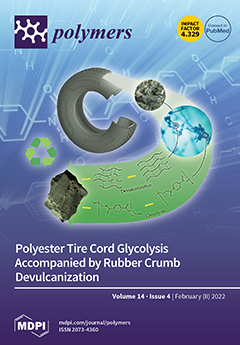With the aim of exploring new materials and properties, we report the synthesis of a thermoplastic chain extended polyurethane membrane, with superior strength and toughness, obtained by incorporating two different concentrations of reactive cellulose nanocrystals (CNC) for potential use in kidney dialysis. Membrane
[...] Read more.
With the aim of exploring new materials and properties, we report the synthesis of a thermoplastic chain extended polyurethane membrane, with superior strength and toughness, obtained by incorporating two different concentrations of reactive cellulose nanocrystals (CNC) for potential use in kidney dialysis. Membrane nanocomposites were prepared by the phase inversion method and their structure and properties were determined. These materials were prepared from a polyurethane (PU) yielded from poly(1,4 butylene adipate) as a soft segment diol, isophorone diisocyanate (IPDI) and hexamethylenediamine (HMDA) as isocyanate and chain extender, respectively (hard segment), filled with 1 or 2%
w/
w CNC. Membrane preparation was made by the phase inversion method using
N,N-dimethylformamide as solvent and water as nonsolvent, and subjected to dead-end microfiltration. Membranes were evaluated by their pure water flux, water content, hydraulic resistance and protein rejection. Polymers and nanocomposites were characterized by scanning electronic and optical microscopy, differential scanning calorimetry, infrared spectroscopy, strain stress testing and
13C solid state nuclear magnetic resonance. The most remarkable effects observed by the addition of CNCs are (i) a substantial increment in Young’s modulus to twenty-two times compared with the neat PU and (ii) a marked increase in pure water flux up to sixty times, for sample containing 1% (
w/w) of CNC. We found that nanofiller has a strong affinity to soft segment diol, which crystallizes in the presence of CNCs, developing both superior mechanical and pure water flow properties, compared to neat PU. The presence of nanofiller also modifies PU intermolecular interactions and consequently the nature of membrane pores.
Full article






